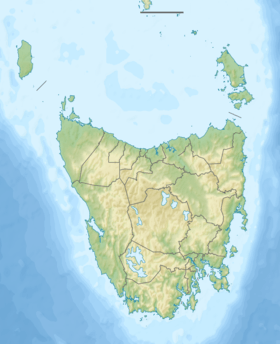Mount Sedgwick (Tasmania)
| Mount Sedgwick | |
|---|---|
|
Mount Sedgwick viewed from higher ground to south east of peak | |
| Highest point | |
| Elevation | 1,147 m (3,763 ft) |
| Coordinates | 42°00′00″S 145°36′36″E / 42.00000°S 145.61000°ECoordinates: 42°00′00″S 145°36′36″E / 42.00000°S 145.61000°E [1] |
| Geography | |
 Mount Sedgwick Location in Tasmania | |
| Location | West Coast, Tasmania, Australia |
| Parent range | West Coast Range |
| Geology | |
| Age of rock | Jurassic, Permian and Palaeozoic |
| Mountain type | Dolerite |
| Climbing | |
| Easiest route | from Lake Margaret Power Station |
Mount Sedgwick is a mountain located within the West Coast Range, in the West Coast region of Tasmania, Australia.
It lies in line behind Mount Lyell in views from high points in Queenstown and from the roads leading out to Strahan and Zeehan. Bands of the pink and grey coloured conglomerate show strikingly on its south west slopes. Its western and south western slopes are significantly more precipitous and rocky, compared to the once heavily forested southern and south eastern slopes.[2]
Geology
The geology of Mount Sedgwick has remnant Jurassic, Permian and Palaeozoic features. The top of Mount Sedgwick is columnar jointed Jurassic Dolerite interpreted as a remnant of a dolerite sheet. The lack of a strong magnetic signature suggests it is not a plug that intrudes Permian tillite, which is exposed on the South East flank of the mountain.[3][4]
Mount Sedgwick and its surrounding area was identified in the 1890s by Thomas Bather Moore as being associated with evidence of glaciation in the West Coast Range.[5]
Access and features
Lake Margaret lies at the northern side of the mountain, while Lake Beatrice and Lake Burbury at the eastern side. Mount Geikie and the Tyndall Range are the main mountains in the West Coast Range to the north. Mount Sedgwick is effectively the source of the Lake Margaret water - with smaller named lakes above Lake Margaret as feeders.
See also
References
- ↑ "Mount Sedgwick (TAS)". Gazetteer of Australia online. Geoscience Australia, Australian Government.
- ↑ Baillie, Peter (2010). "The West Coast Range, Tasmania: Mountains and Geological Giants" (PDF). Papers and Proceedings of the Royal Society of Tasmania (reprint ed.). Hobart, Tasmania: University of Tasmania. 144: 1–13. ISSN 0080-4703. Retrieved 18 June 2015.
- ↑ McNeill, Andrew; Simpson, Kirsten (March 2011). "Pasminco Exploration: Linda EL 13/99, Final Relinquishment Report" (PDF). Department of Mines, Tasmania. Retrieved 17 June 2015.
- ↑ Edwards, A. B. (1940). "On a remnant of a stripped peneplain of Palaeozoic Age at Mount Sedgwick in western Tasmania". National Library of Australia. Retrieved 9 June 2012.
- ↑ Moore, Thomas Bather (1893), Discovery of glaciation in the vicinity of mount Tyndall, in Tasmania, retrieved 10 June 2015
Further reading
- Blainey, Geoffrey (2000). The Peaks of Lyell (6th ed.). Hobart: St. David's Park Publishing. ISBN 0-7246-2265-9.
- Whitham, Charles (2003). Western Tasmania - A land of riches and beauty (Reprint 2003 ed.). Queenstown: Municipality of Queenstown.
